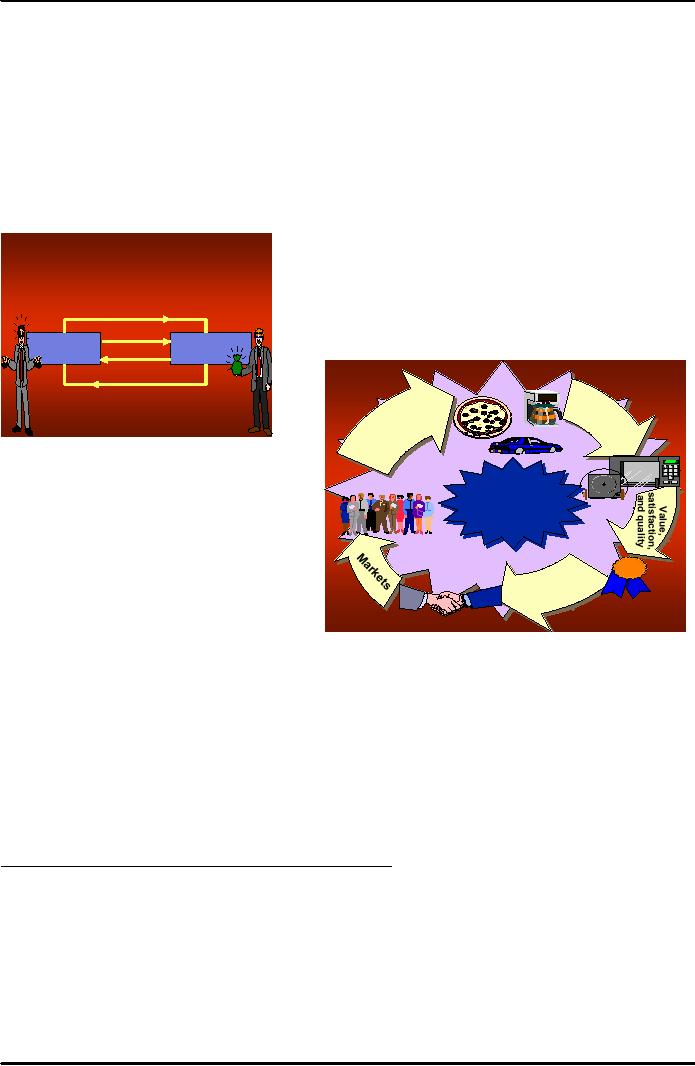 |

Principles
of Marketing MGT301
VU
Lesson
44
Learning
objectives:
After
reading this handout you
will be able to learn the
following areas.
A.
MARKETING
B.
SIMPLE
MARKETING SYSTEM
C.
CORE
CONCEPTS OF MARKETING
D.
CUSTOMER
RELATIONSHIP MANAGEMENT
E.
MARKETING
PHILOSOPHIES
F.
BCG
MATRIX
G.
PRODUCT
MARKET EXPANSION GRID
H.
MARKETING
PROCESS
I.
MARKETING
ENVIRONMENT
J.
MARKETING
INFORMATION SYSTEM AND MARKETING
RESEARCH
K.
CONSUMER
BEHAVIOR
L.
MARKETING
SEGMENTATION
M.
PRODUCT
AND SERVICES
Marketing
Marketing
involves having the right
product available in the
right place at the right
time and
making
sure that the customer is
aware of the product.
Marketing
is part of all of our lives
and touches us in some way every day. To be
successful each
company
that deals with customers on a daily
basis must not only be
customer-driven, but
customer-obsessed.
The best way to achieve this
objective is to develop a sound marketing
function
within the organization.
Marketing is defined as "a social and
managerial process by
which
individuals and groups obtain
what they need and
want through creating and
exchanging
products
and value with others."
Marketing is a key factor in
business success. The
marketing
function
not only deals with
the production and
distribution of products and
services, but it also
is
concerned
with the ethical and social
responsibility functions found in
the domestic and
global
environment.
Marketers must also be aware of customer
value and customer satisfaction and
make
these
concepts a central part of
the firm's strategic plan.
Marketing must also be aware
of and
respond
to change. Four of the
greatest changes that have
had an impact on the way
companies
bring
value to their customers are the
explosive growth of the computer,
the Internet,
telecommunications,
and information technology.
Marketing and its core
concepts, the
exchange
relationship,
the major philosophies of marketing
thought and practice,
customer relationship
management
What
is Marketing?
a.
Creating customer value and satisfaction
are at the very heart of
modern
marketing
thinking and
practice.
b.
A very simple definition of marketing is
managing profitable customer
relationships.
1).
The twofold goal of marketing is to
attract new customers by
promising
superior
value and to keep and grow
current customers by delivering
satisfaction.
2).
Sound marketing is critical to the
success of every organization.
c.
You already know a lot about
marketing--it's all around
you.
220

Principles
of Marketing MGT301
VU
D.
Simple Marketing System
Participants
in a simple marketing
system:
1.
Producer/
seller
2.
Consumer
1.
Producer/
seller
3.
Communication
2.
Consumer
4.
Product/
service
3.
Communication
5.
Money
4.
Product/
service
6.
Feedback
5.
Money
6.
Feedback
E.
Core Marketing
Concepts
Core
Marketing Concepts:
Simple
Marketing
1.
Needs, wants, and
demands
System
2.
Products and Services
3.
Value, satisfaction, and
quality
Communication
4.
Exchange, transactions, and
relationships
Product/Service
5.
Markets
Producer/Seller
Consumer
Money
Feedback
Pr
ts,
od
an
ds
uc
Se
and ts
,w
ds
man
rvi
ce
e
Ne
d de
s
1.
Needs,
wants, and
demands
an
Needs:
Human
needs are the most
basic
Core
Core
concept
underlying marketing. A human
Markettiing
Marke
ng
need
is a state of felt
deprivation.
Conceptts
Concep
s
1).
Humans have many
complex
needs.
a).
Basic, physical needs
for
Exchange,
transactions,
food,
clothing, warmth, and
safety.
and
relationships
b).
Social needs for
belonging
and
affection.
c).
Individual needs for knowledge
and self-expression.
2).
These needs are part of
the basic human
makeup.
Demands:
Another
concept in marketing is human wants. A human
want is the form that
a
human
need takes as shaped by
culture and individual
personality.
Demands:
are
human wants that are backed
by buying power.
Consumers
view products as bundles of benefits and
choose products that give
them the best
bundle
for their money. Outstanding
marketing companies go to great lengths
to learn about and
understand
their customer's needs, wants, and
demands.
2.
Products
and Services
Marketing
Offers--Products, Services, and
Experiences
Companies
address needs by putting
forth a value proposition, a set of
benefits that they promise
to
consumers to satisfy their
needs.
a.
The
value proposition is fulfilled through a
marketing offer--some combination
of
products,
services, information, or experiences
offered to a market to satisfy a
need
or
want.
221

Principles
of Marketing MGT301
VU
b.
The
concept of product is not limited to
physical objects and can
include
experiences,
persons, places, organizations,
information, and
ideas.
c.
Be
careful of paying attention to
the product and not
the benefit being
satisfied.
d.
"Marketing
myopia" is caused by shortsightedness or
losing sight of
underlying
customer needs by only focusing on
existing wants.
e.
Smart
marketers create brand
meaning and brand
experiences for
consumers.
3.
Value,
satisfaction
Customer
value: is the
difference between the values
that the customer gains from
owning and
using
a product and the costs of
obtaining the product. Customers
form expectations about
the
value
of various marketing offers and buy
accordingly.
Customer
satisfaction: depends
on a product's perceived performance in
delivering value relative
to
a buyer's expectations. Customer satisfaction is a key
influence on future buying
behavior.
1).
Marketers must be careful to set
the right level of
expectations.
2).
Customer value and customer satisfaction
are key building blocks
for
developing
and
managing
customer relationships.
4.
Exchange,
transactions, and
relationships
Marketing
occurs when people decide to
satisfy needs and wants
through
exchange.
Exchange
is the act of obtaining a
desired object from someone
by offering something in
return.
Whereas
exchange is a core concept of marketing, a
transaction (a trade of values
between two
parties)
is marketing's unit of measurement. Most
involve money, a response,
and action.
Marketing
consists of actions taken to build
and maintain desirable
exchange relationships with
target
audiences involving a product,
service, idea, or other
object.
5.
Markets
The
concepts of exchange and relationships
lead to the concept of a market. A market is
the set of
actual
and potential buyers of a
product.
1).
originally a "market" was a
place where buyers and sellers
gathered to exchange goods (such
as
a
village square).
2).
Economists use the term to
designate a collection of buyers and
sellers who transact in a
particular
product class (as in the
grain or housing market).
3).
Marketers see buyers as constituting a market and
sellers constituting an
industry.
4).
Marketers are keenly interested in
markets.
F.
Customer Relationship Management
Customer
relationship management (CRM)
has been defined narrowly as a
customer database
management
activity.
Customer
relationship management. "is
the overall process of
building and maintaining
profitable
customer
relationships
by
delivering
superior
customer
value
and satisfaction?"
1).
Today, customer relationship management
is seen as the overall
process of building
and
maintaining
profitable customer relationships by
delivering superior customer value
and
satisfaction.
2).
Traditional marketing practices focused
on attracting new customers rather
than retaining
existing
ones. The move today,
however, is toward building
long-term relationships with
customers
and
other stakeholders.
G.
Marketing Philosophies
There
are five alternative
concepts under which organizations
conduct their marketing
activities:
the
production, product, selling, marketing,
and societal marketing
concepts.
222

Principles
of Marketing MGT301
VU
The
Production Concept
The
production concept holds that consumers
will favor products that
are available and
highly
affordable
and that management should,
therefore, focus on improving
production and
distribution
efficiency. This is one of the oldest
philosophies that guide
sellers.
The
production concept is useful
when:
1).
Demand for a product exceeds
the supply.
2).
The product's cost is too
high and improved
productivity is needed to bring it
down.
The
risk with this concept is in focusing
too narrowly on company operations. Do
not ignore the
desires
of the market. This concept can
lead to "marketing
myopia."
The
Product Concept
The
product concept states that consumers
will favor products that
offer the most
quality,
performance,
and features, and that
the organization should,
therefore, devote its energy to
making
continuous
product improvements.
1).
some manufacturers mistakenly believe
that if they "build a better
mousetrap," Consumers
will
beat
a path to their door just
for their product.
2).
the product concept can also
lead to "marketing myopia,"
the failure to see the
challenges being
presented
by other products.
The
Selling Concept
Many
organizations follow the selling concept.
The selling concept is the idea
that consumers will
not
buy enough of the organization's
products unless the
organization
undertakes a large-
scale
selling and promotion
effort.
1).
this concept is typically practiced
with unsought goods (those
that buyers do not normally
think
of
buying).
2).
to be successful with this concept,
the organization must be
good at tracking down
the
interested
buyer and selling them on
the product benefits.
3).
Industries that use this
concept usually have overcapacity. Their
aim is to sell what they
make
rather
than make what will
sell in the market.
4).
There are not only
high risks with this
approach but low satisfaction
by
customers.
The
Marketing Concept
The
marketing concept holds that achieving organizational
goals depends on determining
the
needs
and wants of target markets
and delivering the desired
satisfactions more effectively
and
efficiently
than competitors do.
Under
the marketing concept, customer focus and
value are paths to sales and
profits. The
marketing
and selling concepts are
often confused. The primary differences
are:
1).
The selling concept takes an "inside-out"
perspective (focuses on existing products
and uses
heavy
promotion and selling
efforts).
2).
The marketing concept takes an
"outside-in" perspective (focuses on
customer needs, values,
and
satisfactions).
Many
companies claim to adopt the marketing concept
but really do not unless
they commit to
market-focused
and customer-driven philosophies.
1).
Customer-driven companies research
current customers to learn about their
desires,
gather
new product and service
ideas, and test proposed
product improvements.
223

Principles
of Marketing MGT301
VU
2).
Such customer-driven marketing usually
works well in a situation of
clear need and
when
customers
know what they
want.
3).
When customers do not know
what they want, marketers
can try
customer-driving
marketing--understanding
customer needs even better
than customers themselves do, and
creating
products
and services that will
meet existing and latent
needs now and in the
future.
The
Societal Marketing
Concept
The
societal marketing concept holds that
the organization should determine
the needs, wants, and
interests
of target markets. It should
then deliver the desired
satisfactions more effectively
and
efficiently
than competitors in a way that maintains
or improves the consumer's and
the society's
well-being.
1).
The societal marketing concept is the
newest of the marketing
philosophies.
2).
It questions whether the
pure marketing concept is adequate given
the wide variety of
societal
problems
and ills.
3).
According to the societal marketing
concept, the pure marketing concept
overlooks possible
conflicts
between short-run consumer wants and
long- run consumer welfare.
4).
The societal concept calls
upon marketers to balance
three considerations in setting
their
marketing
policies:
a).
Company profits.
b).
Customer wants.
c).
Society's interests.
5).
It has become good business
to consider and think of
society's interests when the
organization
makes
marketing decisions.
H.
Boston Consulting Group
Using
the matrix, four
types
of SBUs can be
identified:
20%-
Stars
Question
marks
a).
Stars are
high-
4
?
?
18%-
1
3
growth,
high-share
?
16%-
businesses
or
14%-
5
2
products
(they need
12%-
10%-
heavy
investment to
Dogs
Cash
cow
8%-
finance
their rapid
8
6%-
growth
potential).
4%-
b).
Cash Cows are
6
2%-
7
low-growth,
high-
0
share
businesses or
10x
4x
2x
1.5x
1x
.5x
.4x .3x .2x .1x
products
(they are
Relative
market share
established,
successful,
and need
less
investment to hold
share).
c).
Question Marks are
low-share business units in high-growth
markets (they require a lot
of
cash
to hold their share).
d).
Dogs are
low-growth, low-share businesses and
products (they may generate
enough cash to
maintain
them, but do not have
much future).
224

Principles
of Marketing MGT301
VU
I.
Product/Market Expansion Grid
Companies
should always be looking to
the
future.
One useful device for
identifying
Current
New
growth
opportunities for the future
is the
products
products
product/market
expansion
grid.
The
Market-
Product-
product/market
expansion grid is a portfolio-
Current
penetration
development
planning
tool for identifying company
growth
markets
strategy
strategy
opportunities
through:
1).
Market Penetration--making
more sales
Market-
New
(Diversification
to
present
customers
without
development
markets
strategy)
strategy
changing
products in any way
(example,
adding
more stores).
2).
Market Development--a
strategy for
company
growth by identifying a developing new
markets for current company
products (example,
demographic
and geographical markets).
3).
Product Development--a
strategy for company growth
by offering modified or new
products
to
current markets.
4).
Diversification--a
strategy for company growth
by starting up or acquiring businesses
outside
the
company's current products and
markets.
J.
Marketing Process
Once
the strategic plan has
defined the company's overall mission and
objectives, Marketing plays
a
role in carrying out these objectives.
The marketing process is the
process of analyzing market
opportunities,
selecting target markets, developing
the marketing mix, and
managing the marketing
effort.
Target customers stand at the center of
the marketing process. The
goal is to make
strong
and
profitable connections with
these customers.
K.
Marketing Environment
In
order to correctly identify
opportunities and monitor threats,
the company must begin
with a
thorough
understanding of the marketing
environment in which the
firm operates. The
marketing
environment
consists of all the actors
and forces outside marketing that affect
the marketing
management's
ability to develop and maintain
successful relationships with its target
customers.
Though
these factors and forces may
vary depending on the
specific company and
industrial
group,
they can generally be divided into broad
micro-environmental and
macro-environmental
components.
For most companies, the
micro-environmental components are:
the company,
suppliers,
marketing channel firms (intermediaries), customer
markets, competitors, and
publics.
The
macro-environmental components are
thought to be: demographic, economic,
natural,
technological,
political, and cultural forces.
The wise marketing manager
knows that he or she
cannot
always affect environmental forces.
Smart managers can take a
proactive, rather than
reactive,
approach to the marketing
environment.
As
a company's marketing management collects and
processes data on these
environments, it must
be
ever vigilant in its efforts to apply
what it learns to developing
opportunities and dealing
with
threats.
Studies have shown that
excellent companies not only
have a keen sense of customer
but
an
appreciation of the environmental forces
swirling around them. By
constantly looking at
the
dynamic
changes that are occurring
in the aforementioned environments,
companies are better
prepared
to adapt to change, prepare long-range
strategy, meet the needs of today's
and
tomorrow's
customers, and compete with
the intense competition
present in the global
marketplace.
L.
Marketing Information System
and Marketing
Research
In
carrying out their marketing
responsibilities, marketing managers need
a great deal of
information.
"Information is power" is a legitimate statement.
Despite the importance and
growing
225

Principles
of Marketing MGT301
VU
supply
of information, managers often
lack enough information of
the right kind or have
too much
of
the wrong kind to make
the critical decisions
necessary to be successful in our
highly
competitive
global marketplace. Most marketing
managers don't need more
information, they
need
better
information. To overcome these problems,
many companies are taking
steps to improve
their
marketing information systems. A
commitment to an information system is
not just a
technological
commitment but a corporate culture
commitment as well.
A
well-designed marketing information
system (MIS) first assesses
information needs. The
MIS
next
develops needed information (generally
from internal company data,
marketing intelligence
activities,
marketing research, and information
analysis procedures and
sources). Finally, the
MIS
distributes
information to managers in the
right form at the right
time to help them make
better
marketing
decisions. Once the system
is in place and functioning,
decision-making becomes easier
and
better. Few firms with
efficient information systems
fail in the
marketplace.
Marketing
research, which
is one of the components of an
information system,
involves
collecting
information relevant to a specific
marketing problem facing the company.
The marketing
research
process consists of four
steps: defining the problem
and research objectives,
developing
the
research plan, implementing
the research plan, and
interpreting and reporting
the findings. In
addition
to traditional sources of information
that can now be used
for marketing research,
online
databases
and Internet data sources
are becoming more important to
the marketing research
process.
Marketing
research is the systematic design,
collection, analysis, and reporting of data
and
findings
relevant to a specific marketing
situation facing an organization.
1).
Every marketer needs
research.
2).
Marketing research can be done by an
internal department or it can be done by
an outside firm.
The
marketing research process consists of
four steps: defining the
problem and research
objectives,
developing the research plan,
implementing the research
plan, and interpreting
and
reporting
the findings.
Step
1--Problem
Definition and the Research
Objectives
Step
2--
Developing
the Research Plan
Step
3 --
Implementation
Step
4--
Interpretation
and Reporting of
Findings
M.
Consumer Buying Behavior
Markets
(and those which they serve)
have to be understood before marketing
strategies can be
developed.
The consumer market buys goods and
services for personal
consumption. With
respect
to
the individuals in the consumer market,
the behavior of the consumer is
influenced by the
buyer's
decision process. Buyer
characteristics include four
major factors: cultural, social,
personal,
and
psychological. Each of these factors is explored in
detail. Relationships are drawn
between the
factors
(and factor subparts) and
the consumption purchases
made by consumers. Because
many
of
these factors are deep
and long lasting in their
effect, the marketing
manager should pay
special
attention
to acquiring information about them
with respect to the organization's
target markets.
Decisions
vary based on the degree of
buyer involvement and the
degree of differences among
brands.
For new products, special
situations affect the consumer choice
decision. It has been
found
that consumers respond at different rates
(depending on consumer and
product
characteristics),
gain knowledge about the
products in different ways,
and become aware of
"newness"
with varying rates of consideration.
Factors that speed the
rate of adoption of
new
products
are covered and explained.
Understanding consumer behavior is
difficult enough for
companies
marketing within the borders of a single
country. The problem is
compounded when a
firm
attempts to market in the global
environment.
226

Principles
of Marketing MGT301
VU
Consumer
Black Box
Product
Economic
a)
Consumers make many
Price
Markettiing
and
Marke
ng and
buying
decisions every
Technological
Otther Sttiimullii
Place
O
her S mu
day.
Political
Promotion
b)
A model of consumer
Cultural
behavior
helps managers
Buyer
Buyer's
decision
Buyerr'sBllackBox
Buye
's
Back Box
answer
questions about
characteristics
process
"whatt"&
"how"
"wha" &
"how"
affecting
what
consumers buy,
consumer
where
they buy, how
and
behavior
how
much they buy,
when
they buy, and
why
Purchase
timing
Buyer''s
Response
Product
choice
Buyer
s Response
they
buy.
Purchase
Brand
choice
quantity
1).
Learning about the what,
where,
Dealer
choice
when,
and how much is fairly
easy.
2).
Learning
about
the "why" is much more
difficult.
c)
The central question is: How
do consumers respond to various marketing
efforts
the
company might use.
d)
The stimulus-response model of buyer
behavior shows that marketing
(made up of
the
four P's--product, price,
place, and promotion) and
other stimuli (such as
the
economic,
technological, political, and cultural
environments) center on the
consumer's
"black box" and produce certain
responses.
e)
Marketers must figure out
what is "in" the consumer's
"black box."
f)
The "black box" has
two parts.
1).
The buyer's characteristics influence
how he or she perceive and
react to stimuli.
2).
The buyer's decision process
itself affects the buyer's
behavior.
N.
Market Segmentation
Market
Segmentation: "Dividing
a market into distinct groups with
distinct needs,
characteristics,
or behavior who might require
separate products or marketing
mixes".
Market
segmentation provides a method to divide or segment
the market into narrow
segments
(using
a variety of different meaningful
variables--these variables or bases are
discussed at length
in
the chapter) that can be
better reached with the
resources of the marketer.
Market targeting
examines
each of the designated
segment's attractiveness and
chooses one or more that
match the
marketing
desires and objectives of the
organization. Various coverage
strategies are explained
and
detailed.
The
concept of market positioning arranges
for a product to occupy a
clear, distinctive,
and
desirable
place relative to competition. Various
methods for achieving significant
differentiation
are
explained and illustrated.
The above three steps
aid the marketer in effectively
arranging the
company's
marketing mix so that the
likelihood of consumer response and
competitive advantage
is
maximized by the organization.
Segmentation
Variables
Geographical
segmentation
Demographic
segmentation
Psychographic
segmentation
Behavioral
segmentation
227

Principles
of Marketing MGT301
VU
Requirements
for Effective Segmentation
�
Size,
purchasing power, profiles
of
Measurable
segments
can be measured.
�
Segments
must be effectively
Accessible
reached
and served.
�
Segments
must be large or
profitable
enough to serve.
Substantial
�
Segments
must respond
differently
to different marketing
Differential
mix
elements & actions.
�
Must be
able to attract and
serve
Actionable
the
segments.
Product
& services
Product
is a complex concept that must be
carefully defined. As the first of
the four marketing
mix
variables,
it is often where strategic planning
begins. Product strategy
calls for making coordinated
decisions
on individual products, product
lines, and the product
mix. Products and services
can be
thought
of as occupying three levels:
the core product, the
actual product, and the
augmented
product.
Consumer products are usually
classified according to how
consumers buy them
(convenience,
shopping, specialty, or unsought
products). Industrial goods
are classified
according
to
whether materials and parts,
capital items, and supplies
and services are produced.
The primary
difference
between industrial and consumer
goods is the purpose for
which the product is
bought.
In
addition to tangible products and
services, in recent years marketers
have broadened the
concept
of a product to include other "marketable
entities"--namely, organizations,
persons,
places,
and ideas. Whether an
organization is classed as profit or
nonprofit, marketing has a role
to
play
in the entity. Political
candidates and sports figures are
perhaps the best examples of
how
important
marketing is to person marketing. With the
growth of tourism marketing, many
states,
nations,
and attractions have learned
how to market themselves effectively.
Lastly, idea marketing
(primarily
social marketing issues) has
gained in popularity in the
latter part of this century.
Those
that
study trends in marketing believe that
all of the above areas
will continue to grow and
expand
in
the years ahead.
Companies
have to develop strategies for
the items in their product
lines. They must decide
on
product
attributes, branding, packaging,
labeling, and product support
services. Each of these
areas
is
explained so that the
individual product decision is
seen as a sequence of planned events.
Most
companies
produce a product line rather
than a single product.
Product line and product
mix
decisions
are critical to the success
of the product in a competitive
environment. The product
mix
228

Principles
of Marketing MGT301
VU
describes
the set of product lines
and items offered to customers by a
particular seller. Product
lines
must be managed carefully.
One way to do this is to examine
how to stretch and fill
lines. The
product
mix is described by its width,
length, depth, and consistency. Each of
these tools helps
the
planner
to properly view the product
so it can achieve competitive
superiority and better
product
strategy.
The
twenty-first century may
well indeed be the century
of the brand. There has
been renewed
interest
in the concept of brand equity
(the positive differential effect
that knowing the
brand
name
has on customer response to the
product or service). Solid
brands counter cynical
consumers.
Managing brand is an art
that must be mastered by the
successful marketer. This art
is
increasingly
difficult and complicated with
the emergence of strong global
brands and increasing
competition
for consumer dollars. In reality, a brand's
position will not take
hold fully unless
everyone
in the company lives the
brand.
Services
(although many times
mentioned in the same breath as
product) are different
from
products.
Because the United States
has become a service
economy, it is very important
that the
marketer
understand the strategies associated
with the delivery of
services. The characteristics
of
services
(intangibility, inseparability, variability,
and perish-ability) are
examined and detailed.
The
ability
to differentiate and produce high
quality services is a must
for the services marketer.
Today,
successful
companies focus on the creation of
service-profit chains. To make
these chains work, a
company
may have to undertake internal
and interactive marketing. Service
productivity is as
important
as manufacturing productivity.
229
Table of Contents:
- PRINCIPLES OF MARKETING:Introduction of Marketing, How is Marketing Done?
- ROAD MAP:UNDERSTANDING MARKETING AND MARKETING PROCESS
- MARKETING FUNCTIONS:CUSTOMER RELATIONSHIP MANAGEMENT
- MARKETING IN HISTORICAL PERSPECTIVE AND EVOLUTION OF MARKETING:End of the Mass Market
- MARKETING CHALLENGES IN THE 21st CENTURY:Connections with Customers
- STRATEGIC PLANNING AND MARKETING PROCESS:Setting Company Objectives and Goals
- PORTFOLIO ANALYSIS:MARKETING PROCESS,Marketing Strategy Planning Process
- MARKETING PROCESS:Analyzing marketing opportunities, Contents of Marketing Plan
- MARKETING ENVIRONMENT:The Company’s Microenvironment, Customers
- MARKETING MACRO ENVIRONMENT:Demographic Environment, Cultural Environment
- ANALYZING MARKETING OPPORTUNITIES AND DEVELOPING STRATEGIES:MIS, Marketing Research
- THE MARKETING RESEARCH PROCESS:Developing the Research Plan, Research Approaches
- THE MARKETING RESEARCH PROCESS (Continued):CONSUMER MARKET
- CONSUMER BUYING BEHAVIOR:Model of consumer behavior, Cultural Factors
- CONSUMER BUYING BEHAVIOR (CONTINUED):Personal Factors, Psychological Factors
- BUSINESS MARKETS AND BUYING BEHAVIOR:Market structure and demand
- MARKET SEGMENTATION:Steps in Target Marketing, Mass Marketing
- MARKET SEGMENTATION (CONTINUED):Market Targeting, How Many Differences to Promote
- Product:Marketing Mix, Levels of Product and Services, Consumer Products
- PRODUCT:Individual product decisions, Product Attributes, Branding
- PRODUCT:NEW PRODUCT DEVELOPMENT PROCESS, Idea generation, Test Marketing
- NEW PRODUCT DEVELOPMENT:PRODUCT LIFE- CYCLE STAGES AND STRATEGIES
- KEY TERMS:New-product development, Idea generation, Product development
- Price the 2nd P of Marketing Mix:Marketing Objectives, Costs, The Market and Demand
- PRICE THE 2ND P OF MARKETING MIX:General Pricing Approaches, Fixed Cost
- PRICE THE 2ND P OF MARKETING MIX:Discount and Allowance Pricing, Segmented Pricing
- PRICE THE 2ND P OF MARKETING MIX:Price Changes, Initiating Price Increases
- PLACE- THE 3RD P OF MARKETING MIX:Marketing Channel, Channel Behavior
- LOGISTIC MANAGEMENT:Push Versus Pull Strategy, Goals of the Logistics System
- RETAILING AND WHOLESALING:Customer Service, Product Line, Discount Stores
- KEY TERMS:Distribution channel, Franchise organization, Distribution center
- PROMOTION THE 4TH P OF MARKETING MIX:Integrated Marketing Communications
- ADVERTISING:The Five M’s of Advertising, Advertising decisions
- ADVERTISING:SALES PROMOTION, Evaluating Advertising, Sales Promotion
- PERSONAL SELLING:The Role of the Sales Force, Builds Relationships
- SALES FORCE MANAGEMENT:Managing the Sales Force, Compensating Salespeople
- SALES FORCE MANAGEMENT:DIRECT MARKETING, Forms of Direct Marketing
- DIRECT MARKETING:PUBLIC RELATIONS, Major Public Relations Decisions
- KEY TERMS:Public relations, Advertising, Catalog Marketing
- CREATING COMPETITIVE ADVANTAGE:Competitor Analysis, Competitive Strategies
- GLOBAL MARKETING:International Trade System, Economic Environment
- E-MARKETING:Internet Marketing, Electronic Commerce, Basic-Forms
- MARKETING AND SOCIETY:Social Criticisms of Marketing, Marketing Ethics
- MARKETING:BCG MATRIX, CONSUMER BEHAVIOR, PRODUCT AND SERVICES
- A NEW PRODUCT DEVELOPMENT:PRICING STRATEGIES, GLOBAL MARKET PLACE